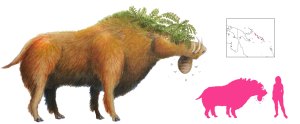
The Kúbání-kikáva reef in Papua New Guinea is home to Pairío, an enormous catfish. She attacks anyone who dares approach the reef by raising up her back, which is armed with spines that can rip a canoe in half. If people see a spine sticking out of the water, they know to change course as fast as possible. Sometimes Pairío will chase after those canoes, one of her spines pointing at the vessel, and the crew have to paddle for their lives.
Pairío herself was not always a catfish. She was once a malignant female spirit known to the islanders as a dógai-órobo, something like the híwai-abére of mainland Papua New Guinea. Her home was on Márukára Island. One day she was attacked by a cloud of butterflies which she could not shoo away; they settled on her thickly until she was completely covered. In desperation she threw herself into the water, where she transformed into a catfish. The butterflies clinging to her soaked through, their wings became hard and spiny, and they turned into stonefishes and catfishes as brightly colored as any butterfly.
References
Landtman, G. (1917) The Folk-tales of the Kiwai Papuans. Acta Societatis Scientiarium Fennicae, t. XLVII, Helsingfors.
Landtman, G. (1927) The Kiwai Papuans of British New Guinea. MacMillan and Co. Limited, London.

